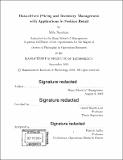| dc.contributor.advisor | David Simchi-Levi. | en_US |
| dc.contributor.author | Nambiar, Mila. | en_US |
| dc.contributor.other | Massachusetts Institute of Technology. Operations Research Center. | en_US |
| dc.date.accessioned | 2020-02-10T21:38:16Z | |
| dc.date.available | 2020-02-10T21:38:16Z | |
| dc.date.copyright | 2019 | en_US |
| dc.date.issued | 2019 | en_US |
| dc.identifier.uri | https://hdl.handle.net/1721.1/123720 | |
| dc.description | Thesis: Ph. D., Massachusetts Institute of Technology, Sloan School of Management, Operations Research Center, 2019 | en_US |
| dc.description | Cataloged from PDF version of thesis. | en_US |
| dc.description | Includes bibliographical references (pages 167-171). | en_US |
| dc.description.abstract | Fashion retail is typically characterized by (1) high demand uncertainty and products with short life cycles, which complicates demand forecasting, and (2) low salvage values and long supply lead times, which penalizes for inaccurate demand forecasting. In this thesis, we are interested in the design of algorithms that leverage fashion retail data to improve demand forecasting, and that make revenue-maximizing or cost-minimizing pricing and inventory management decisions. First, we study a multi-period dynamic pricing problem with feature information. We are especially interested in demand model misspecification, and show that it can lead to price endogeneity, and hence inconsistent price elasticity estimates and suboptimal pricing decisions. We propose a "random price shock" (RPS) algorithm that combines instrumental variables, well known in econometrics, with online learning, in order to simultaneously estimate demand and optimize revenue. | en_US |
| dc.description.abstract | We demonstrate strong theoretical guarantees on the regret of RPS for both IID and non ID features, and numerically validate the algorithm's performance on synthetic data. Next, we present a case study in collaboration with Oracle Retail. We extend RPS to incorporate common business constraints such as markdown pricing and inventory constraints. We then conduct a counterfactual analysis where we simulate the algorithm's performance using fashion retail data. Our analysis estimates that the RPS algorithm will increase by 2-7% relative to current practice. Finally, we study an inventory allocation problem in a single-warehouse multiple-retailer setting with lost sales. We show that under general conditions this problem is convex, and that a Lagrangian relaxation-based approach can be applied to solve it in a computationally tractable, and near-optimal way. | en_US |
| dc.description.abstract | This analysis allows us to prove structural results that give insights into how the allocation policy should depend on factors such as the retailer demand distributions, and demand learning. | en_US |
| dc.description.statementofresponsibility | by Mila Nambiar. | en_US |
| dc.format.extent | 171 pages | en_US |
| dc.language.iso | eng | en_US |
| dc.publisher | Massachusetts Institute of Technology | en_US |
| dc.rights | MIT theses are protected by copyright. They may be viewed, downloaded, or printed from this source but further reproduction or distribution in any format is prohibited without written permission. | en_US |
| dc.rights.uri | http://dspace.mit.edu/handle/1721.1/7582 | en_US |
| dc.subject | Operations Research Center. | en_US |
| dc.title | Data-driven pricing and inventory management with applications in fashion retail | en_US |
| dc.type | Thesis | en_US |
| dc.description.degree | Ph. D. | en_US |
| dc.contributor.department | Massachusetts Institute of Technology. Operations Research Center | en_US |
| dc.contributor.department | Sloan School of Management | |
| dc.identifier.oclc | 1138022422 | en_US |
| dc.description.collection | Ph.D. Massachusetts Institute of Technology, Sloan School of Management, Operations Research Center | en_US |
| dspace.imported | 2020-02-10T21:38:15Z | en_US |
| mit.thesis.degree | Doctoral | en_US |
| mit.thesis.department | Sloan | en_US |
| mit.thesis.department | OperRes | en_US |
